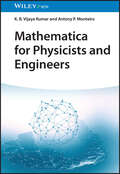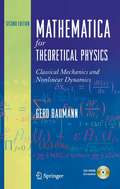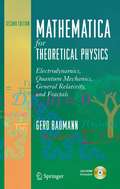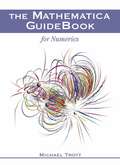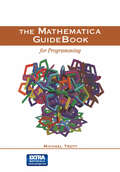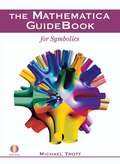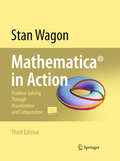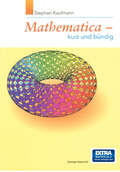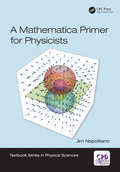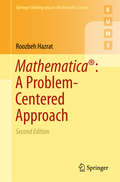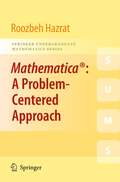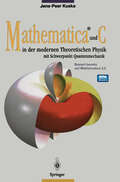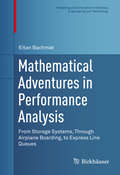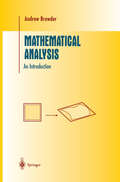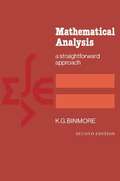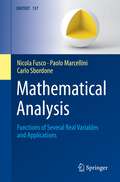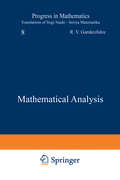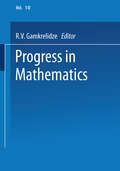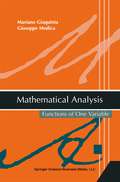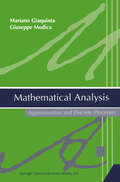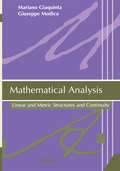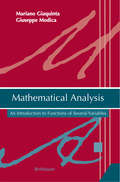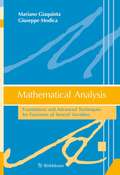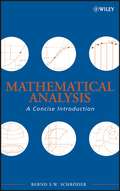- Table View
- List View
Mathematica for Physicists and Engineers
by K. B. Kumar Antony P. MonteiroMathematica for Physicists and Engineers Hands-on textbook for learning how to use Mathematica to solve real-life problems in physics and engineering Mathematica for Physicists and Engineers provides the basic concepts of Mathematica for scientists and engineers, highlights Mathematica’s several built-in functions, demonstrates mathematical concepts that can be employed to solve problems in physics and engineering, and addresses problems in basic arithmetic to more advanced topics such as quantum mechanics. The text views mathematics and physics through the eye of computer programming, fulfilling the needs of students at master’s levels and researchers from a physics and engineering background and bridging the gap between the elementary books written on Mathematica and the reference books written for advanced users. Mathematica for Physicists and Engineers contains information on: Basics to Mathematica, its nomenclature and programming language, and possibilities for graphic output Vector calculus, solving real, complex and matrix equations and systems of equations, and solving quantum mechanical problems in infinite-dimensional linear vector spaces Differential and integral calculus in one and more dimensions and the powerful but elusive Dirac Delta function Fourier and Laplace transform, two integral transformations that are instrumental in many fields of physics and engineering for the solution of ordinary and partial differential equations Serving as a complete first course in Mathematica to solve problems in science and engineering, Mathematica for Physicists and Engineers is an essential learning resource for students in physics and engineering, master’s students in material sciences, geology, biological sciences theoretical chemists. Also lecturers in these and related subjects will benefit from the book.
Mathematica for Theoretical Physics: Classical Mechanics and Nonlinear Dynamics
by Gerd BaumannClass-tested textbook that shows readers how to solve physical problems and deal with their underlying theoretical concepts while using Mathematica® to derive numeric and symbolic solutions. Delivers dozens of fully interactive examples for learning and implementation, constants and formulae can readily be altered and adapted for the user’s purposes.New edition offers enlarged two-volume format suitable to courses in mechanics and electrodynamics, while offering dozens of new examples and a more rewarding interactive learning environment.Notebooks for problem solving and learning.
Mathematica for Theoretical Physics: Electrodynamics, Quantum Mechanics, General Relativity, and Fractals
by Gerd BaumannClass-tested textbook that shows readers how to solve physical problems and deal with their underlying theoretical concepts while using Mathematica® to derive numeric and symbolic solutions.Delivers dozens of fully interactive examples for learning and implementation, constants and formulae can readily be altered and adapted for the user’s purposes.New edition offers enlarged two-volume format suitable to courses in mechanics and electrodynamics, while offering dozens of new examples and a more rewarding interactive learning environment.
The Mathematica GuideBook for Numerics
by Michael TrottProvides the reader with working knowledge of Mathematica and key aspects of Mathematica's numerical capabilities needed to deal with virtually any "real life" problem Clear organization, complete topic coverage, and an accessible writing style for both novices and experts Website for book with additional materials: http://www.MathematicaGuideBooks.org Accompanying DVD containing all materials as an electronic book with complete, executable Mathematica 5.1 compatible code and programs, rendered color graphics, and animations
The Mathematica GuideBook for Programming
by Michael TrottThis comprehensive, detailed reference provides readers with both a working knowledge of Mathematica in general and a detailed knowledge of the key aspects needed to create the fastest, shortest, and most elegant implementations possible. It gives users a deeper understanding of Mathematica by instructive implementations, explanations, and examples from a range of disciplines at varying levels of complexity. The three volumes -- Programming, Graphics, and Mathematics, total 3,000 pages and contain more than 15,000 Mathematica inputs, over 1,500 graphics, 4,000+ references, and more than 500 exercises.This first volume begins with the structure of Mathematica expressions, the syntax of Mathematica, its programming, graphic, numeric and symbolic capabilities. It then covers the hierarchical construction of objects out of symbolic expressions, the definition of functions, the recognition of patterns and their efficient application, program flows and program structuring, and the manipulation of lists.An indispensible resource for students, researchers and professionals in mathematics, the sciences, and engineering.
The Mathematica GuideBook for Symbolics
by Michael TrottProvides reader with working knowledge of Mathematica and key aspects of Mathematica symbolic capabilities, the real heart of Mathematica and the ingredient of the Mathematica software system that makes it so unique and powerful Clear organization, complete topic coverage, and an accessible writing style for both novices and experts Website for book with additional materials: http://www/MathematicaGuideBooks.org Accompanying DVD containing all materials as an electronic book with complete, executable Mathematica 5.1 compatible code and programs, rendered color graphics, and animations
Mathematica® in Action: Problem Solving Through Visualization and Computation
by Stan WagonPlenty of examples and case studies utilize Mathematica 7's newest tools, such as dynamic manipulations and adaptive three-dimensional plotting. Emphasizes the breadth of Mathematica and the impressive results of combining techniques from different areas. Whenever possible, the book shows how Mathematica can be used to discover new things. Striking examples include the design of a road on which a square wheel bike can ride, the design of a drill that can drill square holes, and new and surprising formulas for p. Visualization is emphasized throughout, with finely crafted graphics in each chapter.
Mathematica - Kurz und bündig
by Stephan KaufmannMathematica – kurz und bündig ist eine kompakte Einführung in das in der Mathematik sowie in den Natur- und Ingenieurwissenschaften weitverbreitete Programm Mathematica. Die für den Einstieg wesentlichen Aspekte der Version 3 (Front End, Kernel und wichtigste Standard-Pakete) werden mit einfachen, fachunabhängigen Beispielen erläutert und in Übungsaufgaben vertieft. Anschliessend können die Leserinnen und Leser Problemstellungen aus ihrem Fachbereich, eventuell unter Zuhilfenahme der elektronischen Dokumentation, selbständig lösen. Die beigefügte CD-ROM enthält das ganze Buch in Form von Mathematica-Notebooks mit farbigen Versionen der Grafiken und Animationen. In die Notebooks eingebaute Hyperlinks dienen internen Referenzen und verweisen auf die elektronische Dokumentation des Programms und auf Ressourcen im Internet. Die auf Windows 95/98/NT-, Macintosh- und UNIX-Rechnern verwendbare CD-ROM enthält das Programm MathReader, mit welchem die Notebooks auch ohne eine vollständige Mathematica-Installation betrachtet werden können.
A Mathematica Primer for Physicists (Textbook Series in Physical Sciences)
by Jim Napolitano"…an excellent text for either a short course or self-study… Professor Napolitano has figured out what students really need, and found a way to deliver it… I have found everything he writes to be worthy of my serious attention…" —Peter D. Persans, Professor of Physics and Director, Center for Integrated Electronics, Rensselaer Polytechnic Institute Learn how to use Mathematica quickly for basic problems in physics. The author introduces all the key techniques and then shows how they’re applied using common examples. Chapters cover elementary mathematics concepts, differential and integral calculus, differential equations, vectors and matrices, data analysis, random number generation, animation, and visualization. Written in an appealing, conversational style Presents important concepts within the framework of Mathematics Gives examples from frequently encountered physics problems Explains problem-solving in a step-by-step fashion Jim Napolitano is professor and chair in the Department of Physics at Temple University. He is the author of other textbooks, including co-author with Alistair Rae of Quantum Mechanics, Sixth Edition, also published by Taylor & Francis / CRC Press.
A Mathematica Primer for Physicists (Textbook Series in Physical Sciences)
by Jim Napolitano"…an excellent text for either a short course or self-study… Professor Napolitano has figured out what students really need, and found a way to deliver it… I have found everything he writes to be worthy of my serious attention…" —Peter D. Persans, Professor of Physics and Director, Center for Integrated Electronics, Rensselaer Polytechnic Institute Learn how to use Mathematica quickly for basic problems in physics. The author introduces all the key techniques and then shows how they’re applied using common examples. Chapters cover elementary mathematics concepts, differential and integral calculus, differential equations, vectors and matrices, data analysis, random number generation, animation, and visualization. Written in an appealing, conversational style Presents important concepts within the framework of Mathematics Gives examples from frequently encountered physics problems Explains problem-solving in a step-by-step fashion Jim Napolitano is professor and chair in the Department of Physics at Temple University. He is the author of other textbooks, including co-author with Alistair Rae of Quantum Mechanics, Sixth Edition, also published by Taylor & Francis / CRC Press.
Mathematica®: A Problem-Centered Approach (Springer Undergraduate Mathematics Series)
by Roozbeh HazratThis textbook introduces the vast array of features and powerful mathematical functions of Mathematica using a multitude of clearly presented examples and worked-out problems. Each section starts with a description of a new topic and some basic examples. The author then demonstrates the use of new commands through three categories of problems - the first category highlights those essential parts of the text that demonstrate the use of new commands in Mathematica whilst solving each problem presented; - the second comprises problems that further demonstrate the use of commands previously introduced to tackle different situations; and - the third presents more challenging problems for further study. The intention is to enable the reader to learn from the codes, thus avoiding long and exhausting explanations. While based on a computer algebra course taught to undergraduate students of mathematics, science, engineering and finance, the book also includes chapters on calculus and solving equations, and graphics, thus covering all the basic topics in Mathematica. With its strong focus upon programming and problem solving, and an emphasis on using numerical problems that do not need any particular background in mathematics, this book is also ideal for self-study and as an introduction to researchers who wish to use Mathematica as a computational tool.This new edition has been extensively revised and updated, and includes new chapters with problems and worked examples.
Mathematica®: A Problem-Centered Approach (Springer Undergraduate Mathematics Series #53)
by Roozbeh HazratMathematica®: A Problem-Centered Approach introduces the vast array of features and powerful mathematical functions of Mathematica using a multitude of clearly presented examples and worked- out problems. Each section starts with a description of a new topic and some basic examples. The author then demonstrates the use of new commands through three categories of problems - the first category highlights those essential parts of the text that demonstrate the use of new commands in Mathematica whilst solving each problem presented; - the second comprises problems that further demonstrate the use of commands previously introduced to tackle different situations; and - the third presents more challenging problems for further study. The intention is to enable the reader to learn from the codes, thus avoiding long and exhausting explanations. While based on a computer algebra course taught to undergraduate students of mathematics, science, engineering and finance, the book also includes chapters on calculus and solving equations, and graphics, thus covering all the basic topics in Mathematica. With its strong focus upon programming and problem solving, and an emphasis on using numerical problems that do not need any particular background in mathematics, this book is also ideal for self-study and as an introduction to researchers who wish to use Mathematica as a computational tool. Mathematica®: A Problem-Centered Approach comes with a free 30 day trial of the Wolfram Mathematica(R) software'
Mathematica® und C in der modernen Theoretischen Physik: mit Schwerpunkt Quantenmechanik
by Jens-Peer KuskaDie Behandlung von Problemen der Theoretischen Physik umfaßt die Modellbildung, die mit Mitteln der analytischen Mathematik durchgeführte Vorarbeit sowie die numerische Modellierung. Mathematica und C in der modernen Theoretischen Physik zeigt anhand ausgesuchter Beispiele aus klassischer Mechanik, nichtlinearer Dynamik, Elektrostatik und Quantenmechanik das geschickte Vorgehen mit Mathematica in Verbindung mit der numerischen Modellierung mit C. Das Buch eignet sich für Studierende der Physik und Mathematik sowie für Dozenten, die Demonstrationen für Seminar oder Vorlesung suchen. Die CD-ROM enthält vollständige Quelltexte und Programme für Windows, Linux und Solaris. Die C-Programme entsprechen dem ANSI-Standard und wurden für Windows, Borland C2.0 für OS/2, Watcom C 10.6 u.a. getestet.
Mathematical Adventures in Performance Analysis: From Storage Systems, Through Airplane Boarding, to Express Line Queues (Modeling and Simulation in Science, Engineering and Technology)
by Eitan Bachmat This book describes problems in the field of performance analysis, primarily the study of storage systems and the diverse mathematical techniques that are required for solving them. Topics covered include best practices for scheduling I/O requests to a disk drive, how this problem is related to airplane boarding, and how both problems can be modeled using space-time geometry. Also provided is an explanation of how Riemann's proof of the analytic continuation and functional equation of the Riemann zeta function can be used to analyze express line queues in a minimarket. Overall, the book displays the surprising relevance of abstract mathematics that is not usually associated with applied mathematics topics. Advanced undergraduate students or graduate students with an interest in the applications of mathematics will find this book to be a useful resource. It will also be of interest to professional mathematicians who want exposure to the surprising ways that theoretical mathematics may be applied to engineering problems. To encourage further study, each chapter ends with notes pointing to various related topics that the reader may want pursue. This mathematically rigorous work was noted in the news section of the journal Nature, and in popular media such as New Scientist, The Wall Street Journal, The Guardian, and USA Today.
Mathematical Analysis: An Introduction (Undergraduate Texts in Mathematics)
by Andrew BrowderAmong the traditional purposes of such an introductory course is the training of a student in the conventions of pure mathematics: acquiring a feeling for what is considered a proof, and supplying literate written arguments to support mathematical propositions. To this extent, more than one proof is included for a theorem - where this is considered beneficial - so as to stimulate the students' reasoning for alternate approaches and ideas. The second half of this book, and consequently the second semester, covers differentiation and integration, as well as the connection between these concepts, as displayed in the general theorem of Stokes. Also included are some beautiful applications of this theory, such as Brouwer's fixed point theorem, and the Dirichlet principle for harmonic functions. Throughout, reference is made to earlier sections, so as to reinforce the main ideas by repetition. Unique in its applications to some topics not usually covered at this level.
Mathematical Analysis: A Straightforward Approach (Second Edition)(PDF)
by Margaret DonaldsonFor the second edition of this very successful text, Professor Binmore has written two chapters on analysis in vector spaces. The discussion extends to the notion of the derivative of a vector function as a matrix and the use of second derivatives in classifying stationary points. Some necessary concepts from linear algebra are included where appropriate. The first edition contained numerous worked examples and an ample collection of exercises for all of which solutions were provided at the end of the book. The second edition retains this feature but in addition offers a set of problems for which no solutions are given. Teachers may find this a helpful innovation.
Mathematical Analysis: Functions of Several Real Variables and Applications (UNITEXT #137)
by Nicola Fusco Paolo Marcellini Carlo SbordoneThis work is a textbook on Mathematical Analysis written by expert lecturers in the field. This textbook, other than the classical differentiation and integration tools for functions of several real variables, metric spaces, ordinary differential equations, implicit function and so on, also provides opportunities to go deeper into certain topics: among them, the Ascoli-Arzelà theorem, the regularity of convex functions in R^n, L^p spaces and absolutely continuous functions, all topics that are paramount in modern Mathematical Analysis. Other instances include the Weierstrass theorem on polynomial approximation of continuous functions or Peano's existence theorem (typically only existence, without uniqueness) for nonlinear ODEs and systems under general assumptions.The content is discussed in an elementary way and, at a successive stage, some topics are examined from several, more penetrating, angles. The agile organization of the subject matter helps instructors to effortlessly determine which parts to present during lectures and where to stop. The authors believe that any textbook can contribute to the success of a lecture course only to a point, and the choices made by lecturers are decisive in this respect.The book is addressed to graduate or undergraduate honors students in Mathematics, Physics, Astronomy, Computer Science, Statistics and Probability, attending Mathematical Analysis courses at the Faculties of Science, Engineering, Economics and Architecture.
Mathematical Analysis (Progress in Mathematics #8)
by R. V. GamkrelidzeThis volume contains three articles: "Asymptotic methods in the theory of ordinary differential equations" b'y V. F. Butuzov, A. B. Vasil'eva, and M. V. Fedoryuk, "The theory of best ap proximation in Dormed linear spaces" by A. L. Garkavi, and "Dy namical systems with invariant measure" by A. 'VI. Vershik and S. A. Yuzvinskii. The first article surveys the literature on linear and non linear singular asymptotic problems, in particular, differential equations with a small parameter. The period covered by the survey is primarily 1962-1967. The second article is devoted to the problem of existence, characterization, and uniqueness of best approximations in Banach spaces. One of the chapters also deals with the problem of the convergence of positive operators, inasmuch as the ideas and methods of this theory are close to those of the theory of best ap proximation. The survey covers the literature of the decade 1958-1967. The third article is devoted to a comparatively new and rapid ly growing branch of mathematics which is closely related to many classical and modern mathematical disciplines. A survey is given of results in entropy theory, classical dynamic systems, ergodic theorems, etc. The results surveyed were primarily published during the period 1956-1967.
Mathematical Analysis (Progress in Mathematics #10)
by R. V. GamkrelidzeThe present book contains three articles: "Systems of Linear Differential Equations," by V. P. Palamodov; "Fredholm Operators and Their Generalizations," by S. N. Krachkovskii and A. S. Di kanskii; and "Representations of Groups and Algebras in Spaces with an Indefinite Metric" by M. A. Naimark and R. S. Ismagilov. In the fi.rst article the accent is on those characteristics of systems of differential equations which distinguish the systems from the scalar case. Considerable space is devoted in particular to "nonquadratic systems," a topic that has very recently stimulated interest. The second article is devoted to the algebraic aspects of the theory of operators (determinant theory in particular) in Banach and linear topological spaces. The third article reflects the present state of the art in the given area of the theory of representations, which has been re ceiving considerable attention in connection with its applications in physics (particularly in quantum field theory) and in the theory of differential equations.
Mathematical Analysis: Functions of One Variable
by Mariano Giaquinta Giuseppe ModicaFor more than two thousand years some familiarity with mathematics has been regarded as an indispensable part of the intellectual equipment of every cultured person. Today the traditional place of mathematics in education is in grave danger. Unfortunately, professional representatives of mathematics share in the reponsibiIity. The teaching of mathematics has sometimes degen erated into empty drill in problem solving, which may develop formal ability but does not lead to real understanding or to greater intellectual indepen dence. Mathematical research has shown a tendency toward overspecialization and over-emphasis on abstraction. Applications and connections with other fields have been neglected . . . But . . . understanding of mathematics cannot be transmitted by painless entertainment any more than education in music can be brought by the most brilliant journalism to those who never have lis tened intensively. Actual contact with the content of living mathematics is necessary. Nevertheless technicalities and detours should be avoided, and the presentation of mathematics should be just as free from emphasis on routine as from forbidding dogmatism which refuses to disclose motive or goal and which is an unfair obstacle to honest effort. (From the preface to the first edition of What is Mathematics? by Richard Courant and Herbert Robbins, 1941.
Mathematical Analysis: Approximation and Discrete Processes
by Mariano Giaquinta Giuseppe Modica* Embraces a broad range of topics in analysis requiring only a sound knowledge of calculus and the functions of one variable. * Filled with beautiful illustrations, examples, exercises at the end of each chapter, and a comprehensive index.
Mathematical Analysis: Linear and Metric Structures and Continuity
by Mariano Giaquinta Giuseppe ModicaExamines linear structures, the topology of metric spaces, and continuity in infinite dimensions, with detailed coverage at the graduate level Includes applications to geometry and differential equations, numerous beautiful illustrations, examples, exercises, historical notes, and comprehensive index May be used in graduate seminars and courses or as a reference text by mathematicians, physicists, and engineers
Mathematical Analysis: An Introduction to Functions of Several Variables
by Mariano Giaquinta Giuseppe ModicaThis superb and self-contained work is an introductory presentation of basic ideas, structures, and results of differential and integral calculus for functions of several variables. The wide range of topics covered include the differential calculus of several variables, including differential calculus of Banach spaces, the relevant results of Lebesgue integration theory, and systems and stability of ordinary differential equations. An appendix highlights important mathematicians and other scientists whose contributions have made a great impact on the development of theories in analysis. This text motivates the study of the analysis of several variables with examples, observations, exercises, and illustrations. It may be used in the classroom setting or for self-study by advanced undergraduate and graduate students and as a valuable reference for researchers in mathematics, physics, and engineering.
Mathematical Analysis: Foundations and Advanced Techniques for Functions of Several Variables
by Mariano Giaquinta Giuseppe ModicaMathematical Analysis: Foundations and Advanced Techniques for Functions of Several Variables builds upon the basic ideas and techniques of differential and integral calculus for functions of several variables, as outlined in an earlier introductory volume. The presentation is largely focused on the foundations of measure and integration theory.The book begins with a discussion of the geometry of Hilbert spaces, convex functions and domains, and differential forms, particularly k-forms. The exposition continues with an introduction to the calculus of variations with applications to geometric optics and mechanics. The authors conclude with the study of measure and integration theory – Borel, Radon, and Hausdorff measures and the derivation of measures. An appendix highlights important mathematicians and other scientists whose contributions have made a great impact on the development of theories in analysis.This work may be used as a supplementary text in the classroom or for self-study by advanced undergraduate and graduate students and as a valuable reference for researchers in mathematics, physics, and engineering. One of the key strengths of this presentation, along with the other four books on analysis published by the authors, is the motivation for understanding the subject through examples, observations, exercises, and illustrations.
Mathematical Analysis: A Concise Introduction
by Bernd S. SchröderA self-contained introduction to the fundamentals of mathematical analysis Mathematical Analysis: A Concise Introduction presents the foundations of analysis and illustrates its role in mathematics. By focusing on the essentials, reinforcing learning through exercises, and featuring a unique "learn by doing" approach, the book develops the reader's proof writing skills and establishes fundamental comprehension of analysis that is essential for further exploration of pure and applied mathematics. This book is directly applicable to areas such as differential equations, probability theory, numerical analysis, differential geometry, and functional analysis. Mathematical Analysis is composed of three parts: ?Part One presents the analysis of functions of one variable, including sequences, continuity, differentiation, Riemann integration, series, and the Lebesgue integral. A detailed explanation of proof writing is provided with specific attention devoted to standard proof techniques. To facilitate an efficient transition to more abstract settings, the results for single variable functions are proved using methods that translate to metric spaces. ?Part Two explores the more abstract counterparts of the concepts outlined earlier in the text. The reader is introduced to the fundamental spaces of analysis, including Lp spaces, and the book successfully details how appropriate definitions of integration, continuity, and differentiation lead to a powerful and widely applicable foundation for further study of applied mathematics. The interrelation between measure theory, topology, and differentiation is then examined in the proof of the Multidimensional Substitution Formula. Further areas of coverage in this section include manifolds, Stokes' Theorem, Hilbert spaces, the convergence of Fourier series, and Riesz' Representation Theorem. ?Part Three provides an overview of the motivations for analysis as well as its applications in various subjects. A special focus on ordinary and partial differential equations presents some theoretical and practical challenges that exist in these areas. Topical coverage includes Navier-Stokes equations and the finite element method. Mathematical Analysis: A Concise Introduction includes an extensive index and over 900 exercises ranging in level of difficulty, from conceptual questions and adaptations of proofs to proofs with and without hints. These opportunities for reinforcement, along with the overall concise and well-organized treatment of analysis, make this book essential for readers in upper-undergraduate or beginning graduate mathematics courses who would like to build a solid foundation in analysis for further work in all analysis-based branches of mathematics.
